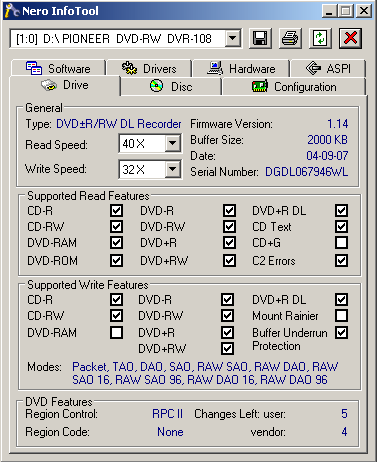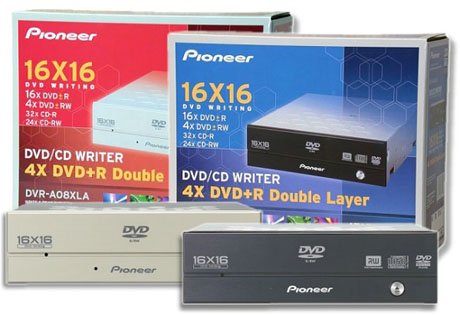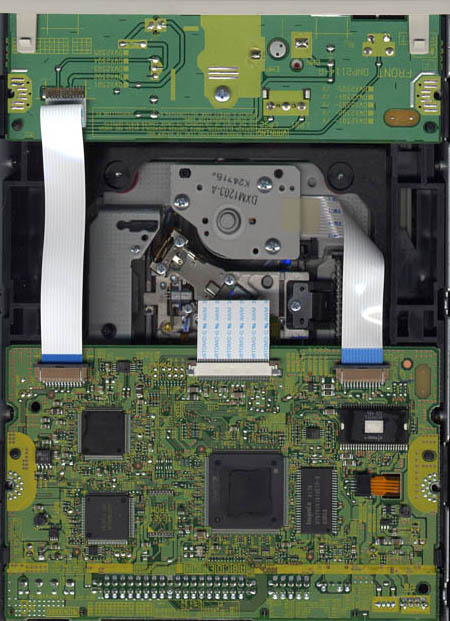Fall 2004 DVDR Roundup: Dual Layer and 16X DVD+R
by Anand Shimpi & Virginia Lee on November 1, 2004 12:05 AM EST- Posted in
- Storage
Pioneer DVR-108D
We took our first look at the Pioneer 108D under the official US firmware (at the time) back in August. Since then, we retested the drive with lots of new media and a newer firmware. Pioneer and NEC arguably share the title of most mature 16X solutions available - both drives have been available for three months now.Below, you can see the individual specifications of the drive.
| Pioneer DVR-108D 16x DVD-/+RW Drive | |
| Interface | PATA |
| CD Write Speed | 32X, 24X ZCLV 16X, 8X, 4X CLV |
| CD Rewrite Speed | 24X ZCLV 16X, 10X, 4X CLV |
| CD Read Speed | 40X MAX CAV |
| DVD-R Write Speed | 16X, 12X, 8X CLV 4X, 2X, 1X |
| DVD-RW Rewrite Speed | 4X, 2X, 1X CLV |
| DVD+R Write Speed | 16X, 12X, 8X ZCLV 4X, 2.4X |
| DVD+RW Rewrite Speed | 4X, 2.4X CLV |
| DVD+DL Write Speed | 2.4X CLV |
| DVD-RAM Read Speed | 2X CLV |
| DVD Read Speed | 16X MAX CAV |
| Supported Modes | DAO / DAO-RAW 16 & 96 TAO SAO / RAW SAO, RAW SAO 16 & 96 Packet Write Multi-Session |
| Supported Formats | DVD+R (DAO, incremental, seq) DVD+RW (random) DVD-R (DAO, incremental, seq) DVD-RW (restricted overwrite) CD-R, CD-RW, CD-ROM, CD-DA, Mixed Mode, CD Extra Photo CD, CD Text, Bootable CD, UDF |
| Access Time | CD: 130ms DVD: 140ms |
| Buffer | 2MB |
Since Pioneer is our definitive 16X recorder that we have already reviewed, we are comparing all of our specifications against it. The most disappointing aspect of the drive that we have noticed during our analysis over these last few weeks has been the (relatively) slow CDR burn speeds. DVDR burn speeds are excellent, and the drive technically supports 4X DVD+DL burn speeds, even though it does not readily advertise such. You can see our original DL tests on the drive here.
Retail versions of the drive come with a redesigned bezel look. For the OEM version that we obtained for the review, the bezel retains the same bland pale design seen in the Pioneer 107 and 106D (and its derivatives).
The drive is recognized in Nero's Infotool as such:

Here's a high resolution scan of the topside of the DVR-108D showing off its label.
Below, you can see another high resolution scan of the drive's internal components.
Our drive came with the NEC D63635GM and C3335 chipsets featuring Hynix DRAM. NEC's D63635 digital signal processor (DSP) was the first to 16X, and thus far, has a very stable track record. Keep in mind, even though the NEC 3500A and the Pioneer 108D utilize the same controllers and servos, they are designed and built completely different. NEC's design revolves around a single double-sided PCB with differing flash/DRAM solutions. The Pioneer drive also supports reading of DVD-RAM media at 5X speeds. There are many similarities between the drives, such as the multi-chip analog controller approach.
A few other drives on the market, like the ASUS DRW-1604P, are built on the same design and chipset, and generally offer identical performance. However, the Pioneer 108D has the most mature firmware and reference design; its performance should equal or surpass other models on the same platform.
Feel free to download the performance graphs for the DVR-108D here.













65 Comments
View All Comments
yourdeardaniel - Tuesday, November 2, 2004 - link
the PO graphs dont work for me.CrazeeHorse - Tuesday, November 2, 2004 - link
Yeah, Belzer is right. NEC have not allowed overspeeding of MCC003 anywhere, your read transfer speeds have been mis-mentioned as your write speeds. MCC003 stays at 8X!Belzer - Tuesday, November 2, 2004 - link
WTF. The write speed tables for 8x MCC DVD±R show the read transfer graph not the write speed.Here are the correct tables for some of the drives (pictures are missing for the LG and the rest are OEM versions so I don't bother to check them):
MCC 02RG20
Time Speed Drive
6:33 10.44x BenQ
6:33 10.22x NEC
6:49 10.01x Pioneer
9:29 7.05x Lite-On
MCC 003
Time Speed Drive
6:26 10.47x BenQ
6:46 10.01x Pioneer
8:11 7.96x Lite-On
9:47 6.72x NEC
And it's the time not the average speed that is interesting so for MCC 004 (again pictures missing for several drives in the zips):
Time Speed Drive
5:50 11.38x BenQ
6:04 11.68x LG
6:50 10.00x Pioneer
Also the BenQ does not cost $90, it costs $67 for the OEM version at Newegg (and you're taking the price of the OEM versions for other drives). Now if you also had bothered to update the firmware to the latest the BenQ would have had the by far best media support too making it the clear winner imo especially as a 4x DVD+R DL firmware update is expected to be released later this month for free.
Maverick215 - Tuesday, November 2, 2004 - link
Ok now I can do even less... will check back tomorrow to see if its working thenMaverick215 - Tuesday, November 2, 2004 - link
>I find that comment inaccurate. Pioneer USA's website is generally *months* behind the Japanese or European versions.I'm not sure what you're trying to say; and perhaps I wasn't clear since you don't seem to understand what I was saying. I am not familiar enough with pioneer's releases to really give you a certain answer. Though my experience with most of my personal hardware is that it is true one country will lag behind, but often times they end up posting the SAME exact firmware, unless there are language changes(do you really think pioneer USA is further certifying xyz firmware release or even recoding it from scratch? or did I miss you point all together?). Seems especially true for larger multinational corporations (left hand doesn't know what the right is doing) so you'll often see the earliest release on the "mother land" website. There will of course be a gradient of this effect since some companies are more tightly knit.
My point was that nutech seems to have used plain vanilla OEM/Bulk firmware in their drive. So updating it with a newer firmware from the same line (not "forked" or otherwise customized) made by the same people would be the same as updating any other OEM'd drive with G series firmware. and the same as updating a retail drive with with the H series firmware.
Maverick215 - Tuesday, November 2, 2004 - link
not letting me post large comments breaking them up:[ok I lied :)]
I thought as much on the 3 drives issue as soon as I posted, sorry I got on a roll :)
>>I think if it's official enough to be on the OEM's website that should be good enough to prove its quality.
Maverick215 - Tuesday, November 2, 2004 - link
Odd...Bozo Galora - Tuesday, November 2, 2004 - link
Well< I got back from BestBuy and what do you know - they had them. Three on the shelf, I scooped them up and paid and out I went. The whole thing took less than 5 min.Cool.
KristopherKubicki - Monday, November 1, 2004 - link
Maverick215: You are correct, those dates are exactly the dates we worked on those images.There are a lot of things in the editorial process that take some time to wade through, although we did the best we could.
>I must also wonder why you chose 3 of the same drive.
Some of those drives we did not expect to be the same when we received them. The NuTech we obviously thought was based on a Sanyo chipset (this was detailed in the review). We had no knowledge of the MSI's chipset before we asked for a review sample.
>I think if it's official enough to be on the OEM's website that should be good enough to prove its quality.
I find that comment inaccurate. Pioneer USA's website is generally *months* behind the Japanese or European versions.
>BTW how did you accomplish bitsetting with the 3500..
The official firmwares past 2.16 (our tested version) support DL bitsetting automatically, anything past 2.26 supports SL bitsetting as well. Since the drives are OEM, they almost always ship with the newest firmware available, and we thought the review should reflect that. Obviously though, we could only test on 2.16.
Kristopher
Maverick215 - Monday, November 1, 2004 - link
Thanks for the zips. I am obviously blind.
As I said I understand you can't TEST the latest and imediately post the review. But typing one or two sentances that outline updated firmware changes (esp if those changes occurred several weeks before your submission) wouldn't take much time (unless you type REAL slow) You obviously had to go back to look at the results of the drives that you already tested to do your final comparison. Wouldn't drastic differences warrant a little more investigation rather than to just say NEC/etc is more mature, end of story?
--
These dates are the apparent test dates (yes I know modified != created, but it's the best we have)
Pioneer 10.13-10.20
NEC 10.13-10.21
BenQ 9.17-9.28
MSI 10.12-10.13
LiteOn 10.13-10.20
Sony 10.5-10.12 (pics of drive 9.27)
LG 10.20-10.21
Nutech 10.20-10.21
While I imagine you were busy with other things, that's quite a gap.
--
I must also wonder why you chose 3 of the same drive.
From the review it seems BenQ, MSI and Nutech are all using the same hardware, differing only by firmware.
BenQ B7J9 9.24.04 (beta, from what I can gather)
MSI M1.4 (can't find directly but others say it's 10.12.04; harder to change this firmware but can still be done, I won't go into it here since it's beyond the scope and likely MSI is more likely to be altering the oem firmware compared to nutech)
Nutech G7H9 8.25.04 (first release solely for 1620 series drives, from what I can gather)
http://www.nu-global.com/1_english/3_products/01_i... no new firmware apparently; though G7H9 would correspond to B7H9 (G is an indication of OEM/Bulk drive supposedly no difference among same revision they also seem to post to benq's european website within a day or so of each other.
ftp://62.253.210.196/dvd-rw/firmware/dw1620a/
(this ftp is what you are redirected to from the official website, the ftp houses the older revisions though)
"retail"
b7h9.zip 8/25/2004
b7k9.zip 9/29/2004
b7l9.zip 10/13/2004
b7m9.zip 11/1/2004
"bulk"/oem'd
g7k9.zip 9/30/2004
g7l9.zip 10/13/2004
g7m9.zip 11/1/2004
--
What the heck does all this rambling mean!?!?!??!
in short you could have easily upgraded your nutech to G7K9 (OEM released firmware) and tested it since you apparently didn't test it untill later in october, well after G7K9 was released, perhaps you might have even squeezed in G7L9.
Yes, you might say that it's not an "official firmware" it will void your nutech warranty!!
But when the manufacturer refuses to update their website, what choice does the consumer, who wants the most out of his/her hardware, have.
from nutech's website:
"This warranty is void if: (yatta yatta) If the unit is repaired, modified or altered, unless such repair, modification or alteration is expressly authorized in writing by NU.
(yatta yatta)"
I must say it is worth noting that none of the firmware downloads from NU's site that I looked at contained any such written authorization.
I think if it's official enough to be on the OEM's website that should be good enough to prove its quality.
On a side note, one might wonder "is such an upgrade a modification or alteration?" I'm inclined to call it a repair :)
--
BTW how did you accomplish bitsetting with the 3500.. To my knowledge NEC hasn't released a tool to do this (when I say NEC, I mean dl'able from nec.com, not mdmm.com(oem'd)) and if done in nero I was under the impression that there is a limit to the number of times this can be done (an enforced limit, ie it's coded in like RPC changes rather than the memory "wearing out") just wondering.
--
ok three very long posts that rehash the same thing.. unless there's something new I yield.